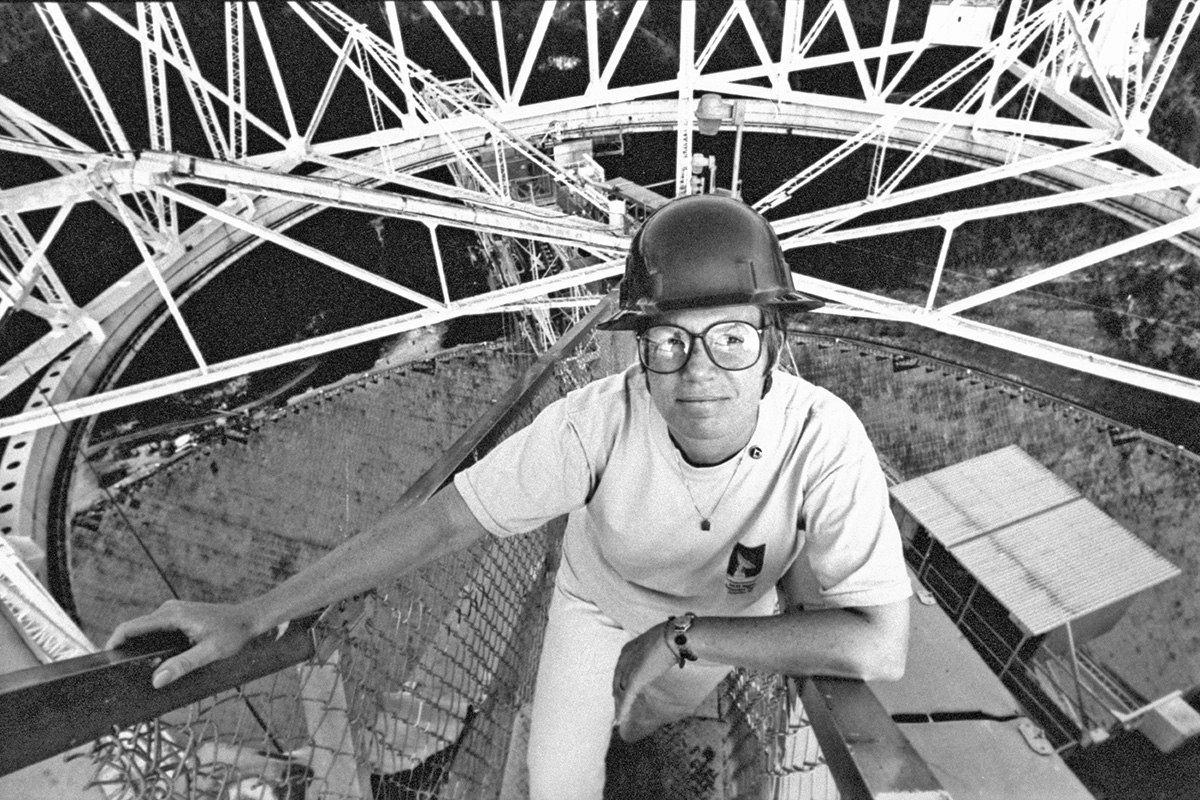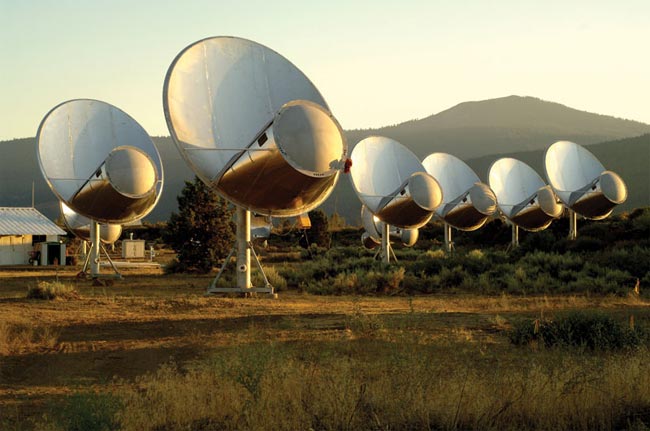'Search for Extraterrestrial Intelligence' Needs a New Name, SETI Pioneer Says

IRVINE, Calif. — Astrophysicist Jill Tarter is one of the world's best-known leaders in the search for extraterrestrial intelligence, or SETI. For 35 years, she served as the director of the Center for SETI Research (part of the SETI institute) and was also the project scientist for NASA's SETI program, before its cancellation in 1993.
Despite her longtime association with that four-letter acronym, Tarter says it's time for "SETI" to be rebranded.
At a recent meeting of the National Academy of Sciences' Committee on Astrobiology Science Strategy for the Search for Life in the Universe, held here at the University of California, Irvine, Tarter explained that the phrase "search for extraterrestrial intelligence" generates an incorrect perception of what scientists in this field are actually doing. A more appropriate title for the field, she said, would be "the search for technosignatures," or signs of technology created by intelligent alien civilizations. [13 Ways to Hunt Intelligent Aliens]
"We need to be very careful about our language," Tarter said during a presentation at the committee meeting on Jan. 18. "SETI is not the search for extraterrestrial intelligence. We can't define intelligence, and we sure as hell don't know how to detect it remotely. [SETI] … is searching for evidence of someone else's technology. We use technology as a proxy for intelligence.
"[The acronym] 'SETI' has been problematic in history, and we should just drop [it] and just continue to talk about a search for technosignatures," she said.
Signs of life
What constitutes a "technosignature"? Tarter reviewed some of the possibilities that she and other SETI scientists have proposed.
"We have a pragmatic definition for technology, which is the ability to deliberately modify an environment in ways that can be sensed over interstellar or interplanetary distances, including the unintended consequences of that modification," Tarter said. "Life does this, but it doesn't do it deliberately."
Sign up for the Live Science daily newsletter now
Get the world’s most fascinating discoveries delivered straight to your inbox.
One technosignature that scientists have been actively seeking for decades is communication signals. These could include signals used by members of an alien civilization to communicate with each other or attempts to communicate with other civilizations. The SETI Institute continues to search for alien communications in radio waves, using the Allen Telescope Array. (Tarter was the inspiration for the main character in Carl Sagan's novel "Contact," which was adapted into a movie; in that story, aliens make contact with Earth via radio waves.) But recent SETI efforts have expanded to look for other mediums of alien communication, and SETI scientists have theorized that an interstellar civilization might use laser light to communicate.
Science-fiction writer Arthur C. Clarke wrote that "any sufficiently advanced technology is indistinguishable from magic," which would mean that alien technology could be as mysterious and unexplainable to humans as technologies that appear in science-fiction TV shows and movies. That opens up a dauntingly large range of possibilities for what technosignatures might look like. What if an alien civilization were communicating via a mechanism that Earth-based scientists haven't discovered yet? Would humans immediately recognize these "magical" technosignatures, or would we not see them as unnatural?
Tarter said she prefers to focus on a slight alteration of Clarke's prediction written by the futurist Karl Schroeder: "Any sufficiently advanced technology is indistinguishable from nature."

"[The system] will be so efficient that there will be no wastage, and [it] will appear to be natural," Tarter said. If this prediction is correct, it might also be impossible for humans to identify technosignatures from very advanced civilizations. But Tarter uses it as a jumping-off point to brainstorm how scientists might identify technologies that have not yet reached that level of sophistication.
In the field of exoplanet science, new techniques and new instruments are increasing scientists' ability to study exoplanets and gather information about their atmospheres and surface conditions. The central focus in that field is to find habitable planets, or planets with "unintelligent" life-forms (like plants). Tarter said those tools could also provide the opportunity to look for signs of technology that artificially alters a planet's climate or conditions.
"As we begin to look for exoplanets and image them, you might get an unexpected glint, [because] maybe mirrors re cooling their planet, reflecting light away from the planet," Tarter said.
But a technosignature wouldn't necessarily have to be the detection of the technology itself. The artificial alteration of a planet's climate could be revealed simply because the planet in question is too close or too far away from its parent star to have the observed climate. A star system with multiple planets that all have similarly moderate, habitable climates, despite their particular proximity to the parent star, could indicate large-scale bioengineering by an intelligent civilization, Tartar said.
"[An alien civilization] also might want to decrease latitudinal variation in temperature; maybe they want more of their planet to be nice and cozy," Tarter said. "It's going to take a lot of energy to do that, but I don't know the physics that says you can't."
![By surrounding their star with swarms of energy-collecting satellites, advanced civilizations could create Dyson spheres. [Read the Full Dyson Sphere Infographic Here.]](https://cdn.mos.cms.futurecdn.net/A5qkGM3DWqrXZpJzfGg2Zo.jpg)
Into the future
The search for technosignatures is daunting, but Tarter says now is "a really opportunistic time" for it. The field is benefiting from new instruments and a wider array of instruments. SETI scientists are often searching through large volumes of data, seeking the proverbial needle in the haystack. Artificial intelligence and artificial "neural networks" can help aid this effort by combing through this vast data to search for signals that the scientists program machines to find and also allowing "the data to tell us what kind of signals are there," Tarter said, which increases the odds of finding an unanticipated technosignature.
Tarter listed multiple SETI projects and initiatives that are underway around the world. The most high-profile is Breakthrough Listen, a private initiative that has funded a group of researchers at the University of California, Berkeley to utilize various telescopes to search for signs of alien communication or other possible technosignatures. The Berkeley group has led an effort to crack the mystery of Boyajian's star, which has exhibited a very strange pattern of dimming and brightening. A few years ago, some researchers proposed that perhaps the strange light patterns were created by an alien megastructure orbiting the star — a fantastic example of a technosignature. Though that possibility has largely been ruled out, the Breakthrough Listen researchers are still working to understand this phenomenon.
The challenge of searching for alien technosignatures may be daunting, but Tarter remains unwavering in her optimism for the search for life beyond Earth.
"In 2004, Craig Venter and Daniel Cohen made a really bold statement: They said the 20th century had been the century of physics, but the 21st century would be the century of biology," Tarter said. "I think they were right, but I don't think they were bold enough. Because I think the 21st century is going to be the century of biology on Earth and beyond."
Follow Calla Cofield @callacofield. Follow us @Spacedotcom, Facebook and Google+. Original article on Space.com.










